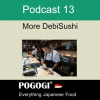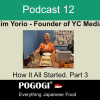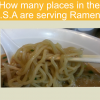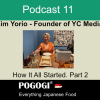Podcast 8 - Talking Tea with Ippodo
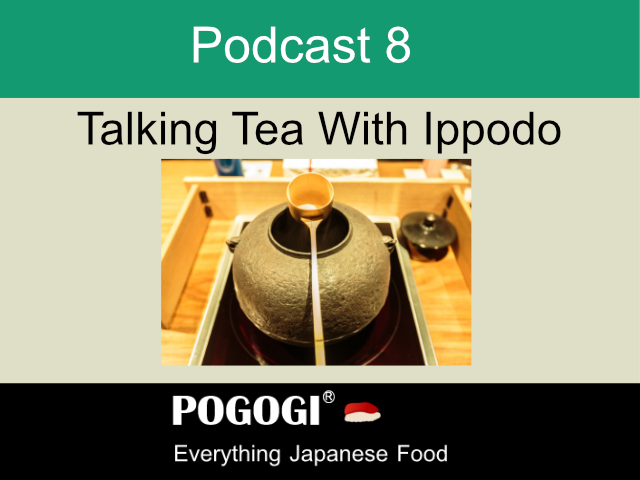
Ippodo Tea, New York
125 East 39th St.
New York, NY 10016
http://www.ippodo-tea.co.jp/en/shop/ny.html

Podcast Transcript:
Po: Okay, back at you with another piggy podcast. This is PO, and I'm with my partner in crime Gi. Back in October 2014, we did an interview with Mr Kenichi Kano, who at the time was the international director of a Ippodo Tea, which is a family run business based in Kyoto, Japan.
And they've been selling extremely high quality Japanese tea since the 17 hundreds. More specifically, 1717, they've been featured in travel and leisure, food and wine, The New York Times for magazine, Buzzfeed, Pop Sugar and Bon Appetit, just to name a few.
Now we're really excited to follow up on our first interview with Ippodo Tea with Tomoko Honda, the manager of Ippodo Tea, New York location, who's joining us all the way from Kyoto, Japan. And before I forget, I'd like to thank Amy Bianca from Y C media for making today's podcast possible.
So with that, we'd like to welcome all the way from Japan. Tomoko, thanks for being with us.
Tomoko: Thank you for having me today.
Po: It's our pleasure.
So let's start Tomoko with our standard issue question because, of course, our site is all about Japanese food. What's your favorite Japanese food?
Tomoko: Um, that's a very difficult question. I like eating everything, but, I like rice and I also I'm from Kansai area Kyoto, so I like Okonomiyaki.
Po: Right. Awesome! Now, Tomoko, our last guest, Mr Travis Kamiyama, who has built quite a name for himself, mentioned that his favorite Japanese food was something that even Japanese food lovers may not have heard of, which is which Ochazuke. Now for those who may wish to make this meal at home, what kind of Japanese tea would you recommend for this particular dish?
Tomoko: I would say, light, a little bit a stringent side of green tea or could be roasted green tea that we called Hojicha. Yeah, basically, those are very good.
And we also have, green tea with puffed rice called Genmaicha. I believe that goes very well with Rice too.
Po: Yeah, for sure. Now for this, for this next question Tomoko. I'm curious about your thoughts. So there's a lot to be said about pairing wine, whether red or white, with certain foods.What kind of Japanese tea would you recommend? That would pair well, let's say, popular Japanese foods like sushi or sashimi or tempura or dishes like that. Do you have any recommendations?
Tomoko: With sushi, maybe I would go for Sencha or lighter side of Gyokuro, which is a little bit more aggressive vegetable type of green tea. Sencha is a little bit more balanced, kind of green tea between richness and bitterness. Those two should be very good with sushi.
And I like a little bit lighter, astringent type of green tea with like sashimi meat and tempura type of food.
Po: And now I'm curious because you're calling in from Kyoto at the moment. That's your from Kansai area, right? This question just kind of came to me. I think some of our listeners would be very interested.
If someone were to say, travel to Kyoto, do you have any recommendations on food or, um, things of that nature beverages? Or that they should try?
Tomoko: Kyoto used to be the old capital in Japan. So the center of the culture, you can find any type of Japanese very authentic, very good Japanese food. So, yeah, that's for sure.
But also, you can find cuisine from all over the world to and some great Chefs. You know use both good sides from Japanese cuisine, Japanese culture, and also from cuisine from different countries. That would be also very interesting.
Po: I remember when I was in Kyoto. I can't remember what year this was, but we were in the Gion district, and there was, I don't know if you would call it a dish, necessarily. But it was like shaved ice. I believe it was. Macha poured over the shaved ice, and then they had, like, gold leaf on the top. Yeah, and it didn't look like it would be very flavorful, right? Because it was it looked like just a pile of shaved ice, but it was quite delicious.
Tomoko: Yeah, that's called Kakigori, shaved ice, well it's so popular in Japan.
Po: I felt quite special. Yeah, because it had the Gold Leafs on the top, I thought it was the best thing.
You know like when you go to Ramen bar or something like that in Japan. They have those little spouts of hot water. And they have that little, it looks like a little cup in a little spoon with it. Looks like Matcha powder, right? What is that?
Tomoko: That is powdered green tea, but not Matcha. And so technically Matcha has to come from shaded tea fields, so before picking, like two weeks before picking season, they put shade to cut the sunlight. That enhances, like umami flavor, grassy taste of Macha. So technically, Matcha has to come from that type of tea field.
But, those powder teas at sushi bars or Ramen bars are from open fields, so they don't put the shade. So it has a lighter, more stringent taste.
And then they picked tea leaves. And then I think they just crash into powder form as opposed to ground in a stone mill like Matcha. So it's I think it's more convenient type of powdered green tea.
Po: I mean, I was almost 100% certain that it wasn't actually Matcha.
Tomoko: Yeah, but even some Japanese people think that.
Po: Because I imagine that would start to get really expensive.

Now Ippodo Tea, like clearly you folks sell some very high quality products. Aside from that fact, how would you say Ippodo is able to cater to, let's say, some very sophisticated clients beyond the product itself. And how do you differentiate yourself from the competition when it comes to Tea?
Tomoko: So when it comes to Tea companies, each company has their own favorite taste profile. You know, it's an option for everybody. It's not that this taste should be, everybody should like this tea.
But you can and you want to choose from many options. So it's not necessarily, we sell high quality, higher quality than other companies are like that. I want people to have many choices as possible. And yeah, what we focus or what we try is to, give as much information as possible to customers.
Currently in the US, we focus on the U.S. market and so when people want to know about tea or about culture, we want to be the first source of information for them.
Po: That makes sense. Speaking of information, and culture and things like that. So you've been in the tea business for quite a while, right?
Tomoko: Yes, 300 years.
Po: I'm just curious, like, in your experience, what's the most interesting thing you've discovered? Or learn about Japanese tea throughout your career in this business?
Tomoko: I was born and raised in Japan, but it's not that I knew how to properly prepare Japanese tea. You know, even in Japan now, you can have bottled green tea or whatever beverage at convenience stores everywhere, so not all Japanese people know how to prepare tea properly.
So first thing I learned at Ippodo is how to. And also, I learned about many different types of Japanese green tea. I knew about Gyokuro, but I don't think I have ever tried it before joining the company.
But now, of course, I know every kind of Japanese green tea and, you know, like you said, I like to choose this Sencha for this meal and Gyokuro for this cuisine. And that's a very interest in part of life for me right now.
Po: Do you have any tips Tomoko, for instance, people who are very interested in, let's say, like the tea ceremony or just learning about Japanese tea in the first place. Like you said, there's a lot to learn, there's a variety of different teas. And I think for a lot of people that could be quite intimidating. Do you have any quick tips on getting someone interested and how to how to perhaps allow them to learn about Japanese tea easier?
Tomoko: If you want to learn about, Japanese tea ceremony, there’s some schools, so you may want to look for it. But if not, if you want to just enjoy Japanese green tea in your daily life, then I think what you should know first, that it’s not that difficult to prepare Japanese Green tea, so you don't need to get too nervous about it.
So if you want to prepare Japanese tea, the important things are just like three things. The temperature, water and steeping time, and the amount of tea leaves and water. That's the only things you need to consider beforehand.
I want people to feel relaxed and enjoy while however you they like.
Po: So how about the steeping time? What would your recommendation be? Is it dependent on the type of tea that they're brewing?
Tomoko: Yes, exactly. So basically, when you use lower temperature of water, you want to steep longer time. And when you use higher temperature water or boiling water, you want to steep shorter time. That's the basic thing to remember.
For Gykoro we usually steep about 90 seconds, but for roasted green tea or for Genmaicha, we use boiling water. So we just brew, like, 30 seconds.
Po: Interesting. So you know how some people have a sweeter palate and some people have preference for more savory foods? Would there be certainties that would match up with those kind of preferences?
Tomoko: Yes, of course. So generally speaking, Gykoro is naturally sweeter, more savory type of green tea. And Sencha it’s something you can enjoy a little bit more bitterness and astringency. That is one of the things you want to consider.
Or also, even in central category, there are many different grades. Uh, so higher grade of Sencha, are naturally sweeter and less bitter and lower grade of Sencha will be more astringent and lighter. So, yeah, you have many choices.
Po: What does the American market tend to favor?
Tomoko: Matcha
Po: Gotcha. Okay. Are they purchasing it to drink as tea? Or are you noticing some are purchasing it for baking.
Tomoko: I think more people are buying for drinking, like at straight or even with milk as latte. Yeah, but of course there are people who use Matcha for baking and sweets.
So what's your opinion on, you know, there's been a lot of desserts and pastries and things like that that use Macha. Do you think and do you feel that's kind of a, I don't know how I would describe it. Do you feel that it's a good thing for Japanese tea in terms of popularity and recognition? Or do you think it kind of corrupts the purity of tea?
Tomoko: No, I think I'm glad that many people get to know, Matcha from through sweets. So I think it's a very good thing, and it's also very good for Matcha farmers as well, and more and more demands in the U.S. Market because of Matcha sweets. So I think it's a very good thing.
I would love more and more people who get to know much as through sweet, but become more interested in Matcha itself like drinking Matcha as it is.
Po: Yeah, I quite like Matcha in desserts and pastries. Actually, I find it cuts the sweetness quite well.
Tomoko: Yeah, it's the balance, you know, of the sugar sweetness and the Matcha bitterness.
Po: Now, when we did our first interview with Mr. Kano back in 2014, we asked him where he saw the company in 10 years, and that was back like I said in 2014, it hasn't being quite that long, but it's getting close. At that time, he mentioned possibly seeing a growing demand across Asia, the US, Europe, the Middle East and South America. So where is Ipoddo today? And where do you think it's going to be in another 10 years?
Tomoko: Mr. Kano was completely right about it, and then now the U.S market is the largest outside of Japan for us. And back in, I think that was, like 2015 or 2016, I came to New York just for a business trip, and I made Matcha and many people didn't know about Matcha. People were like, oh, well is that a natural color or something like that?
But now, living in New York, most people know what Matcha is. So it's a very in a completely different world right now and then we've even launched, US online store. So the market that's been big enough for that. And yes, we've seen increases in Asia and European market as well.
Po: Now the location that you manage in New York, I don't know what kind of affects COVID has on people being able to go into the store. But could you give us a description of what people could expect if and when they're able to go back and physically visit the store?
Tomoko: So we were originally just to go place, so even before Covid, we didn't have any sitting area, so we were just like a Tea bar. But we are located, close to Grand Central Terminal, so in the office area. So people used to come to the store after lunch hours, office people, and to grab Macha latte or Japanese Green Tea before going back to the office.
And now, obviously, we don't see, those people right now, but we are still open for those to go service. And of course, we sell tea and tea wears, so people can prepare at home.
Po: What's the most popular kind of tea wear that you find sells well?
Tomoko: Well, I think Matcha bamboo whisk. That's the most essential utensil for preparing Matcha.
Po: And correct me if I'm wrong Tomoko. But when you're using that bamboo whisk, I think some people have, or they tend to kind of whisk it in a circular motion. But I could be wrong, but I think the proper way to use that whisk is just a straight back and forth. Is that correct?
Tomoko: I wouldn't say it's wrong to do in a circular motion, so the point is you need to mix powder and water very well. So even if with a circular motion a back and forth, it's okay if you get good Matcha.
But usually we do back and forth big or vigorous motion. I think that's the most easiest way to mix powder and water.
Po: And is there a proper ratio to the tea powder and water?
Tomoko: We do like, 4g of macha powder for eight ounces up to go cup.
Po: Well, Tomoko we're almost at a time. So I'd like to thank you very much for taking time out of your business scheduled to join us. We were originally expecting this podcast to be done with you from New York, but I guess your schedule got changed up a little bit. So again, we really appreciate that.
And if it's okay, maybe we can follow up with you in the future to see what you and your Ipoddo Tea are up to.
Tomoko: Of course. Thank you very much.
Po: That would be great. So, folks, if you guys have a chance to visit the website that would be fantastic. They have some awesome products and thank you again Tomoko and for Amy arranging this for us. We really appreciate it, and we'll check you out on the next podcast. Thanks again for joining us. And we'll see you next time



